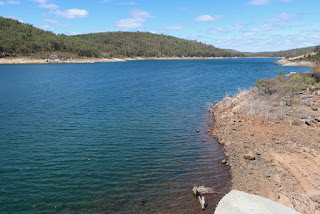Mundaring Weir
When I first met Wendy's dad, Bob, in Durban in the 1960s, I mentioned I had met a lady who lived in a town about half an hour's drive from Perth - and to my surprise, he knew of it! He told me how, many years before in the early days of his career in the Royal Navy, his ship had called in at the port of Freemantle, south of Perth.
On a day when they were off duty, he and a couple of his brother officers had hired a car to visit Mundaring Weir, the dam that had been built across the Helena River, creating a lake to supply water to the Mount Charlotte Reservoir in Kalgoorlie, some 566 km (over 350 miles) away.
Charles Yelverton O'Connor, an Irish/Australian engineer, was instrumental in formulating this scheme; originally built of steel, it was called CY O'Connor's golden pipeline, and constructed between 1898 and 1903.
It was one of the world's great engineering projects at the time, and when it opened in 1903, it was the world's largest fresh water pipeline, supplying water to the eastern goldfields in Coolgardie and Kalgoorlie.
The last time it overflowed was in 1996, which gives an indication of how little rain falls in this area; sometimes the water level is so low, old railway tracks lying of at the bottom of the dam become visible.
It has a storage capacity of about 37179 (ml), and when I last checked, it was around 58.5% full; this can change!
Tragically, after much criticism in the press at the time when the weir was being built, C Y O'Connor felt his reputation and character had been so undermined, he committed suicide on 10th March 1902. A few weeks after his death, pumping trials began at the Number 1 Pump Station; water flowed as each section of the pipeline was laid, until on 16th January 1903, the residents of Kalgoorlie were able to enjoy fresh water pumped from the Helena River. What a difference it made; and what a great pity C Y O'Connor had felt such despair 10 months earlier.
The pipeline was known as The Golden Pipeline because of the "Golden Fleece" - 6 million sheep rely on it; the "Golden Sheaves of the Wheatbelt," and of course Gold, from Australia's richest goldfields.
After World War II, the wall at Mundaring Weir was raised by 32 feet. Great care had to be taken with this operation; new concrete was placed alongside the old wall, with slots to keep the new section free from the original section. This was to allow time for the new concrete to cure and shrink as it set; if it had been placed directly on top of the old material, a crack would have developed. After the temperature of the old and new sections had equalised, the slots were filled in.
For that group of Naval Officers out on a day's "jolly" away from their Royal Naval vessel, touring the pumping station and seeing the size of the major turbines required to transport the vital water so far away, proved to be a most interesting expedition.
In 2004, the Helena River Reservoir was renamed as Lake C.Y. O'Connor
Wendy on the observation bridge, on the concrete weir wall above the Dam
There is a Golden Pipeline Heritage Trail that tracks the pipeline from its source at Mundaring Weir to Kalgoorlie, and it is promoted to motorists with a couple (or more!) days to spare. Apart from the Goldfields Road, it follows the old Eastern Railway reserve where trains steamed, and the maintenance road beside the water supply pipeline; along the way are many interesting places to stop off and explore, and towns to stay en route.
The water from Mundaring Weir spends at least a week in the pipeline to reach its destination; what an adventure it would be, to allot a few days to follow it from start to finish!

.jpeg)
.jpeg)




















